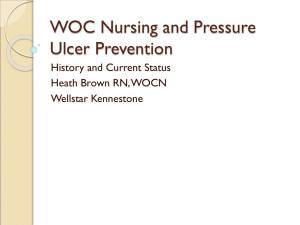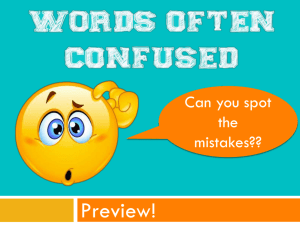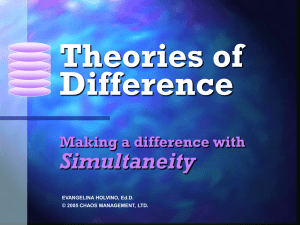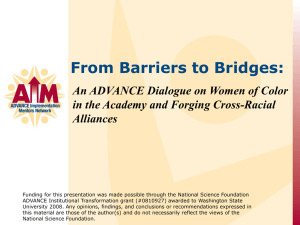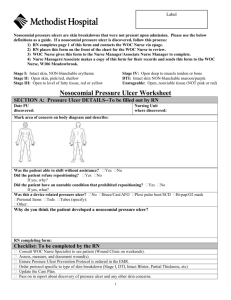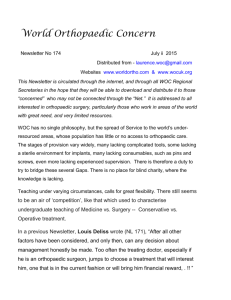AIM-Allies-Powerpt-template-updated
advertisement
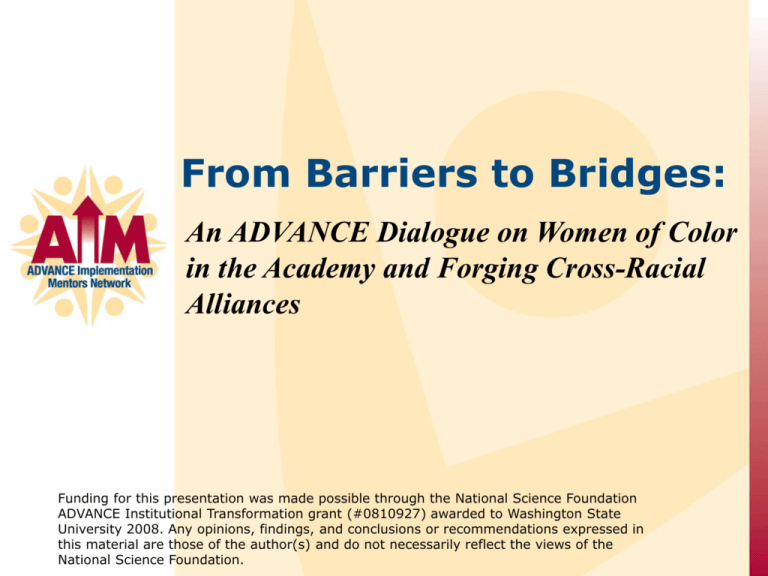
From Barriers to Bridges: An ADVANCE Dialogue on Women of Color in the Academy and Forging Cross-Racial Alliances Funding for this presentation was made possible through the National Science Foundation ADVANCE Institutional Transformation grant (#0810927) awarded to Washington State University 2008. Any opinions, findings, and conclusions or recommendations expressed in this material are those of the author(s) and do not necessarily reflect the views of the National Science Foundation. Welcome to Diversity 101 The Office: What Not to DO! Overview • The Foundation for the Conversation • Why Should We Care? • Defining Women of Color (WOC) and Intersectionality • Higher Education Context for WOC • ADVANCE Context for WOC • ADVANCE Implementation Mentors (AIM) Network • AIM Network WOC Allies & Partners Project • ADVANCE Programs Specific to WOC • AIM Network WOC Survey Results • Interview Results • WOC Data • Change Agents and Allies • Practice and Next Steps Foundation for the Conversation Why Should We Care? • Scientists should reflect US racial/ethnic demographics • Diverse groups have higher group performance (Phillips, Liljenquist, & Neale, 2009). • Cultural and social determinants of health need the attention of diverse scientists • Technological advancements are enhanced by diverse developers • Race alters the experience of gender and gender alters the experience of race (Morris, 2007). An Engineering Example Why Race Matters? • HP Face-tracking Software Defining Women of Color (WOC) • US historical underrepresentation in STEM compared to US representation (Ong, Wright, Espinosa, & Orfield, 2011). • NSF defines WOC as African American, Native American, and Hispanic/Latina Women. • Asian women are not under-represented in STEM fields (Burrelli, 2009); however they are underrepresented in leadership. • Asian American and International women differ from White Women and WOC . This project includes data and interviews from International and Asian American women. Intersectionality “Intersectionality theory holds that modes of inequality, such as race, gender, and class, can combine in ways that alter the meaning and effects of one another.” (Morris, 2007) • “Race alters the very meaning and impact of gender and gender alters the very meaning and impact of race” Higher Education Context: Student Diversity Pipeline The race/ethnicity of students planning to major in S & E has become more diverse over time (1995; 2010): • • • • White students planning to major in S&E declined (77% to 71%) Asian American/Asian students increased (7% to 12%) Hispanic students increased (5% to 13%) American Indian/Alaska Native and black students accounted for roughly 2% and 11%, respectively, of freshmen intending to major in S&E in both 1995 and 2010 (NSF, 2012) Female students: • white first year students (31%) expressed lower intentions to major in S & E compared to Asian (38%), African American (35%), Hispanic American (38%) in 2010 (NSF, 2012). Research on WOC in STEM has focused on undergrad women. There is a scarcity of research on WOC graduate students or faculty (Ong, 2010). Higher Education: Faculty Gender Diversity • Women account for 21% full professors, 37% associate professors and 42% of junior professors (NSF, 2012). Faculty Race Diversity • 75% of full-time faculty are White Males (Hoopes, 2013) • 6% of full professors in the US are Black, Hispanic, or Native American (NSF, 2013) • 4% of underrepresented minority professors are in Research I institutions (NSF, 2013) Exercise • Who do you take to lunch from the department/office? • Who are your close friends? • Who are your neighbors? • Who teaches your children, addresses your health and/or legal needs? ADVANCE Context for WOC AIM Network History • Initiated: ADVANCE PI meeting (Nov. 2010) • Target Audience: ADVANCE Program Coordinators/Directors (i.e., IT, PAID, Catalyst grants) • Goal: To optimize efficiency and effectiveness of national ADVANCE efforts by establishing a Community of Practice yo provide ADVANCE Program Coordinators & Directors with: • on-demand support • intra-and-inter cohort mentoring • efficient information dissemination • best/promising practices identification AIM Network Objectives • Establish a listserv (Dec. 2010) • Establish a monthly meeting (Jan. 2011) • 2nd Tuesday of the month (8:30 PST) • Establish a means for storing and sharing documents (Jan. 2011) • WEPAN Knowledge Center: AIM Network Interest Group AIM Network Membership Membership has continued to grow over the last 3 years… 100 90 80 70 60 50 40 30 20 10 0 86 62 52 27 January, 2011 January, 2012 January, 2013 July, 2013 AIM Network Members AIM Network Members at the 2011 NSF Joint Annual Meeting. WOC Allies & Partners Project ADVANCE NSF Supplemental Grant • Webinar (Nov. 1st, 2012) • Op Ed Project Training (Post ADVANCE Workshop, March 6th, 2013) • AIM Network Website Development (Aug. 1st, 2013) • WOC PowerPoint • WOC Reference List • WOC ADVANCE Data • Project Evaluation WOC-Specific ADVANCE Programs • Rutgers University (2008) ADVANCE IT: Women of Color Scholars Program • Syracuse (2010) ADVANCE IT Chancellors Faculty Fellow Program • Texas A & M (2010) ADVANCE IT: Scholar Mentor Program • ADVANCE HBCU Women Faculty • University of Montana PACE (2003)ADVANCE IT: outreach to American Indian Women Scientists • Indigenous Women in Science Network WOC-Specific ADVANCE Programs (Continued) • MentorNet (2010) PAID • Purdue (2008) ADVANCE IT • Howard University (2012) ADVANCE IT • Jackson State University (2010) ADVANCE IT • RIT (2012) ADVANCE IT • IWPR (2012) PAID • Other? AIM Women of Color: Survey • 9 question survey (Mar. 20th- June 8th, 2012) • Predominately ADVANCE IT institutions represented • Three main survey questions: 1. Do ADVANCE Program Coordinators/Directors have the tools to be Allies/Advocates for WOC STEM faculty ? (i.e. WOC data, knowledge of barriers and factors for success for WOC, collaborators) 2. What are ADVANCE programs offering for WOC? 3. What ADVANCE activities do Program Coordinators/Directors perceive are going well (or not so well) re: WOC? AIM WOC: Survey Results • 45% completion rate (i.e., 17/38) • Data collection precipitated good discussions and provided the focus for two AIM meetings • ADVANCE institutional challenges noted: WOC data not collected and/or difficult to find data, cohort related) WOC Survey: Question 1 What is the % of Women of Color faculty at your institution? 100% 90% % Institutional Responses 80% 70% 60% 53% 50% 41% 40% 30% 20% 6% 10% 0 0% 0-5% 6-10% 11-15% 0 16-20% % Women of Color Faculty >20% WOC Survey: Question 2 # of Institutions What types of activities does your ADVANCE program offer specifically to Women of Color faculty? (please check all that apply)* 10 9 8 7 6 5 4 3 2 1 0 9 8 8 7 4 Women-of-Color-Specific Programs Note*: 9/17 answered this question WOC Survey: Question 3 What do you perceive as barriers to success for Women of Color faculty at your institution (please check all that apply)? Institutional Reponses 16 14 12 10 8 6 4 14 10 10 10 8 8 5 4 1 2 0 Barriers to Women of Color Faculty WOC Survey: Question 4 What do you perceive as factors that promote success for Women of Color faculty at your institution (please check all that apply)? 16 Institutional Reponses 14 14 14 12 12 10 10 9 8 7 6 4 2 0 Networking Mentoring Retention Efforts Recruitment Focus Focus on WOC Cluster Hiring Promoting Success for Women of Color Faculty WOC Survey: Rate Aspects of Your Program for WOC Poor Fair Good Very Good Excellent N/A Data Collection 12% (2) 0% (0) 6% (1) 29% (5) 47% (8) 6% (1) Promoting Success 6% (1) 29% (5) 24% (4) 12% (2) 12% (2) 18% (3) Retention Efforts 6% (1) 29% (5) 18% (3) 18% (3) 6% (1) 24% (4) Enhancing Climate 6% (1) 23% (4) 29% (5) 18% (3) 6% (1) 18% (3) Recruitment 24% (4) 35% (6) 24% (4) 12% (2) 0% (0) 6% (1) Different Issues Identified for WOC/WW 18% (3) 12% (2) 47% (8) 6% (1) 6% (1) 12% (2) WOC Survey: List Barriers For Asian American Women • Isolation • Implicit Cultural Biases. • “Model Minority” Stigma • Classroom Challenges • Majority ignorance of barriers faced— unintentional biases (e.g., advancement ceiling). WOC Survey: List Barriers For International Women • Isolation (i.e., Few women with the same cultural issues) • Visa Issues. • Cross-cultural issues (i.e., language) • Lack of models, especially in upper levels of the academy • Dual-culture gender biases • Work-life balance extended outside of the US • Culture issues from their own country WOC Survey: Comments • “Our numbers are so small it’s hard to make any comments that are of statistical significance.” • “Data collection is challenging. How do we provide the few WOC we have with a voice, while at the same time providing confidentiality?” • “Until we create a climate where WOC are successful (i.e., retained, mentored, less isolated) through active support from majority faculty, I am ambivalent about how much benefit WOC-specific programs will provide.” Interviews with WOC • “My experience has revealed that my own belief that I am just as capable and competent as males, particularly white males, has determined my career success. When I doubted my capabilities then I was treated as if my capabilities were inferior. However, when I valued my capabilities and believed that I brought to the table valuable assets, then I was treated as if I had something of value. My experience also reveals that there is a culture of disrespect for those who are different.” Interviews with WOC • “I believe the barriers to success for minority women in science is the feeling of being disconnected and the lack of appropriate role models and mentors. For me, I still feel like I am an outsider among fellow scientists, like I still have to prove myself before I will be taken seriously or be considered for opportunities for career advancement. In science there is no clear map to success, but for minority scientists, particularly women, we are less likely to even be aware of opportunities that are available. “ Interviews with WOC • “I believed that if I work hard my superior will see that and make fair decisions about my position. The truth is I need to sell myself as competent and as an asset. ” • “The leadership is made up primarily of males and I think this implicitly sends the message that females are unwanted, not valued, or not perceived as not being as capable as males. ” Interviews with WOC • “…very favorable for women at the higher administration end, as this is an HBCU. Within the department of chemistry there is still the impression that it is male-dominated and certain underlying currents occasionally come up (i.e., when decisions are made, directions for department, etc.) that suggest the male faculty on board still think this is a male dominated field.” Interviews with WOC • “Minority women may have more of a family responsibility. If our family is relying on our paycheck then we may not want to be considered "trouble makers" by not accepting the disrespect and disregard from the administration and colleagues.” • Other barriers experienced include the lack of: • Mentoring • Resources • Collaboration Women of Color Faculty Data B.S.’s Awarded to Women by Field and Race/Ethnicity (2010) National Science Foundation, National Center for Science and Engineering Statistics, Survey of Doctorate Recipients, 2010. 10,000 9,000 30,627 8,323 7,849 8,000 7,000 6,000 5,000 4,501 4,859 4,356 4,569 3,493 4,000 3,000 2,000 634 1,295 1,000 590 323 63 0 Biology White Computer Science Asian 1,008 659 Hispanic 422 411 35 Math Black 1,918 1,346 628 563 43 Physical Sciences 805 77 Engineering Native American M.S.’s Awarded to Women by Field and Race/Ethnicity (2010) National Science Foundation, National Center for Science and Engineering Statistics, Survey of Doctorate Recipients, 2010. 1,400 3,213 2,409 1,200 1,130 1,005 1,000 800 887 716 683 463 600 400 469 319 352 366 334 206 159 200 28 10 0 Biology White Computer Science Asian Black 132 48 56 7 Math Hispanic 65 65 Physical Science 26 2 Engineering Native American Ph.D.’s Awarded to Women by Field and Racial/Ethnicity (2010) National Science Foundation, National Center for Science and Engineering Statistics, Survey of Doctorate Recipients, 2010. 600 551 1955 508 500 400 385 300 172 200 174 168 147 107 84 100 15 0 Biology White 34 11 7 39 D Computer Science Asian Black 9 8 37 D Math Hispanic 52 50 65 4 2 Physical Engineering Science Native American D = suppressed to avoid disclosure of confidential information Total S & E Faculty by Sex (2010) National Science Foundation, National Center for Science and Engineering Statistics, Survey of Doctorate Recipients, 2010. 70,000 60,400 60,000 50,000 40,000 30,000 20,000 31,800 27,600 16,300 18,900 14,500 10,000 0 Assistant Associate Male Female Full S&E Faculty Rank by Sex and Race/ Ethnicity (2010) National Science Foundation, National Center for Science and Engineering Statistics, Survey of Doctorate Recipients, 2010. Assistant Associate Full White 13,000—Female (18,100)—Male 12,300 (24,200) 12,300 (49,600) Black 1000 (1,200) 800 (1,400) 500 (1,100) Hispanic 1,100 (1,500) 900 (1,300) 400 (2,000) Asian 3,400 (6,300) 2,000 (4,400) 1,100 (7,000) <100 <100 100 <100 <100 100 Native American Women Assistant Professors by Field (2010) National Science Foundation, National Center for Science and Engineering Statistics, Survey of Doctorate Recipients, 2010. 2000 4,200 1800 1,500 1600 1400 1,100 1200 1000 700 800 700 600 500 600 400 400 200 0 200 100 200 D * 300 * D Computer Info. Systems * Math White D= D 200 Physics Hispanic D D D Black Biology Asian 100 100 D Engineering Native American suppressed to avoid disclosure of confidential information *= value < 50 Women Full Professors by Field (2010) National Science Foundation, National Center for Science and Engineering Statistics, Survey of Doctorate Recipients, 2010. 2000 3,700 1800 1600 1,500 1400 1200 1000 800 800 600 600 400 400 300 200 200 0 D D D D Computer Info. System White D D Math D 100 D 100 Physics D 100 100 Biology D D D 100 D Engineering Hispanic Black Asian Native American D = suppressed to avoid disclosure of confidential information Change Agents and Allies Advocates and Allies • Little “a” advocate/ally; and big “A” Advocate/Ally • Who’s invited to the “table” and who isn’t? • Opportunities for Alliance Building (Houston, 2007, AACU) • Invisibility and Silencing • Underestimating • Shifting Criteria White Women Allies • Recognize the impact of race and gender • Acknowledge privilege • Interrupt hostile behavior and microaggressions • Are conscious about who’s at the table and not present in the decision making process Women of Color Allies Dace (2012) • Don’t hold on to old wounds • Be open to alliances • Openly acknowledge and embrace white women allies Talking About Race • Tim Wise: How Whites Talk About Race (2 minutes) “Whites are taught to think of their lives as morally neutral, normative, and average, and also ideal, so that when we work to benefit others, this is seen as work which will allow ‘them’ to be more like ‘us.’” Peggy McIntosh, White Privilege: Unpacking the Invisible Knapsack Practice and Next Steps Think-Pair-Share Exercise Think, discuss with partner (ideally a person of a different race or ethnicity) & share with the broader group: • What stops us from having race/ intersectionality conversations? • How can we facilitate these conversations? • What does racism look like in your department (or maybe, more broadly, in the academy?) • When recruiting faculty we are always seeking “the best.” How is “best” defined and how is the answer ultimately a manifestation of a privileged majority? • What are “action steps” for you as a change agent and/or ally? Recommended Readings • Dace, K. (2012). Unlikely Allies in the Academy: Women of Color and White Women in Conversation. New York, NY: Routledge. • Houston, M. (2007). Communicating as a Crosscultural Ally. AACU. • McIntosh, P. (1988). Unpacking the Knapsack of White Privilege. • MIT (2010): A Report on the Initiative for Faculty Race and Diversity. • Ong, M. & et. al (2010): Inside the Double Bind: A synthesis of empirical research on WOC in STEM. • Trower, C. & Chat, R. (March-April 2002) Faculty Diversity: Too little for too long. Harvard Magazine. • Turner, C. (2002). Women of Color in Academe: Living with Multiple Marginality. Journal of Higher Education, 73 (1). Learn about the AIM Network or the WOC Allies & Partners Project AIM Network/WOC Allies & Partners Project • Gretal Leibnitz, Ph.D. ADVANCEAIMNetwork@gmail.com OR Leibnitz@advanceAIMnetwork.org WOC Allies & Partners Project • Ming Shi Trammel, Ph.D. Formerly ADVANCE NC State University mingtrammel@gmail.com

